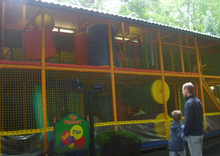Family entertainment center
This article has multiple issues. Please help improve it or discuss these issues on the talk page. (Learn how and when to remove these template messages)
|
A family entertainment center (FEC) in the entertainment industry,
History
FECs are essentially a converged outgrowth of
Attractions

Most FECs have at least five common major or "anchor" attractions, to provide diverse patrons (often in large parties) at least one to two hours of entertainment, to encourage repeat visits, and to reduce time spent waiting for any given attraction.[1] Some of the more usual attractions include (depending upon size, climate, etc.):
- Amusement/thrill rides(elevated, but generally small-scale)
- Animatronics displays
- Arcade games
- Ball pit
- Batting cages
- Bowling alley
- Bumper boats
- Restaurant
- Food: Snack bar and fast food (often pizza)
- Food: Quality family and group dining in theme restaurant
- Inflatables
- Kiddie rides (ground-level)
- Kart racing
- Laser tag
- Miniature golf
- Movie theater
- dancing
- Playground equipment and climbing structures
- Redemption games and merchandiser games
- Roller skating
- Specialty stores(toys, comics, music, etc.)
- Tube maze
- Virtual Reality
- Water slide

The most common anchor activities are miniature golf, kart racing, arcade and redemption games, and food & beverages, according to industry specialists StoneCreek Partners.[1] FECs rarely use custom-built attractions, because of the costs involved, and instead install off-the-shelf systems provided and maintained by industry equipment vendors.[1]
Any given FEC may lean more towards outdoor activities, arcade gaming, or passive entertainment and dining. Each may cater to different age ranges, all the time, or during certain hours, e.g., children and entire families in the daytime, and teens to young adults in the evening, with specific promotional programs to attract different market segments at different times.[1]
Business model
FECs tend to serve "sub-regional markets",[1] such as small cities, quadrants or boroughs of larger cities, and a large suburban area outside such a city. Their busiest times are weekend afternoons and Thursday through Saturday evenings.[1]
Because most of the attractions are essentially the same from FEC to FEC,[1] two of the most important factors in a particular center distinguishing itself to potential customers are a highly visible location[1] (hard to obtain because other uses for the land are often more competitive[1]), and a consistently developed and promoted theme that appeals to the target market segments, "the fun factor in the overall decor".[1]
Parental concerns are also important. While children themselves rarely think of it, a major factor in the attractiveness of an FEC to parents is on-site safety and security, as adults may drop off older children at such an establishment to entertain themselves.[1] An increasingly important factor for success is high-quality food and drink to attract parental spending as well as whole-family dining.[1]
Non-traditional FECs
Various major media and entertainment brands, including
Some nonprofit, educational installations, such as the
In Canada
- Chuck E. Cheese (U.S.-owned)
- Playdium
- Galaxyland at West Edmonton Mall (formerly named Fantasyland)
In Mexico
- KidZania (Mexico City, 1999)
- America's Incredible Pizza Company (Monterrey, U.S.-owned)
In the United Kingdom
- The Living Rainforest
- Water World, Stoke-on-Trent
- Sea Life London Aquarium
- Madame Tussauds
In the United States
The main national industry group in the U.S. is the National Association of Family Entertainment Centers (NAFEC), which is a division of the International Laser Tag Association (ILTA).
Some U.S.-based companies also have venues in Canada (noted above), but this is rare due to the legal/political difficulties involved in cross-border corporations.
North American FECs vary wildly in themes, size and features. Some of the larger businesses in this category have included:[1]
- Adventure Landing (Jacksonville Beach, Florida, 1995)
- America's Incredible Pizza Company (chain, based in Springfield, Missouri, 2002)
- Boomers! Parks (chain)
- Brunswick Zone XL (bowling/pool/video game chain)
- Castle Park (full amusement park with FEC section, Texas)
- Chuck E. Cheese (chain, based in San Jose, California, 1977)
- Dave & Buster's (Dallas, Texas, 1982)
- Discovery Zone (Lenexa, Kansas, 1990)
- GameWorks (Seattle, Washington, 1997)
- Mr. Gatti's Pizza
- waterparkand miniature golf course with FEC section, California and Arizona)
- John's Incredible Pizza Co.(1997)
- Legoland Discovery Center(Schaumburg, Illinois, 2008)
- Malibu Grand Prix
- NASCAR Speedpark (NASCAR racingtheme; four U.S. locations)
- Peter Piper Pizza (chain)
- Putt-Putt Fun Center
- Regal FunScape (chain; movies, minigolf, video & "VR" games, food court, etc., depending on location)
- Round1 Bowling and Amusement and Spo-Cha(chain, Japan-owned)
- Scandia Amusement Park(full amusement park with FEC section, California)
- Sky Zone (chain, indoor trampoline park; locations in US and Canada)
- Sony Metreon(San Francisco, California, 1999–2006, Japan-owned)
- Tilt Studio (chain, an offshoot of the original Tilt arcade chain)
- Universal CityWalk
- Universal Studios Hollywood (Los Angeles, California, 1993)
- Universal Orlando Resort(Orlando, Florida, 1999)
- uWink (2007)
- ZDT's Amusement Park (full amusement park with FEC section, Texas)
In other countries
- Entertainment City (Manila Bay, Philippines)
- Happy City (Colombia)
- Round1 (Japan)
- Sega Republic (Dubai, United Arab Emirates2009, Japan-owned but closed down)
- Universal CityWalk (part of Universal Studios Japan, Osaka, U.S.-owned)
- Ferrari World Abu Dhabi (United Arab Emirates)
- Trans Studio Makassar (Makassar, Indonesia)
- Joypolis (Japan)
- Dazzeland (Adelaide, Australia 1991-1998, now closed)
See also
References
- ^ a b c d e f g h i j k l m n o p q "About Family Entertainment Centers". StoneCreekLLC.com. Las Vegas, Nevada: StoneCreek Partners Advisory Services, Commercial Real Estate and Leisure-time Industries. 2011. Retrieved May 12, 2011.
- ISSN 0261-3077. Retrieved 2023-05-18.
- ^ McAuliffe, Howard (2023-06-16). "The Evolution And Potential Of Urban Entertainment Centers". Pinnacle Entertainment Group. Retrieved 2023-07-31.
- ^ a b "Urban Entertainment Centers". StoneCreekLLC.com. op. cit. 2011.
{{cite web}}: Missing or empty|url=(help) - ISBN 9780130293503.
